Related Research Articles

Matthias was, according to the Acts of the Apostles, chosen by God through the apostles to replace Judas Iscariot following the latter's betrayal of Jesus and his subsequent death. His calling as an apostle is unique, in that his appointment was not made personally by Jesus, and it came before the descent of the Holy Spirit upon the early Church.
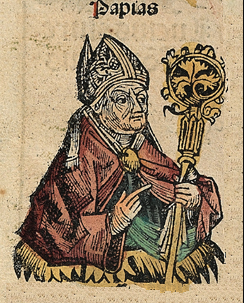
Papias was a Greek Apostolic Father, Bishop of Hierapolis, and author who lived c. 60 – c. 130 AD He wrote the Exposition of the Sayings of the Lord in five books. This work, which is lost apart from brief excerpts in the works of Irenaeus of Lyons and Eusebius of Caesarea, is an important early source on Christian oral tradition and especially on the origins of the canonical Gospels.
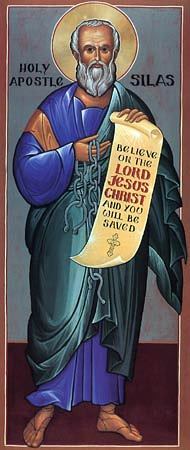
Silas or Silvanus was a leading member of the Early Christian community, who according to the New Testament accompanied Paul the Apostle on his second missionary journey.

James the Just, or a variation of James, brother of the Lord, was, according to the New Testament, a brother of Jesus. He was the first leader of the Jerusalem Church of the Apostolic Age. Traditionally, it is believed he was martyred either in AD 62 by being stoned to death on the order of High Priest Ananus ben Ananus, or in AD 69 by being thrown off the pinnacle of the Temple by scribes and Pharisees and then clubbed to death. James, Joses, Simon, and Judas are mentioned as the brothers of Jesus as well as two or more unnamed sisters.

Simon the Zealot, also the Canaanite or the Canaanean was one of the apostles of Jesus. A few pseudepigraphical writings were connected to him, but Jerome does not include him in De viris illustribus written between 392 and 393 AD.

Acts of Thomas is an early 3rd-century text, one of the New Testament apocrypha within the Acts of the Apostles subgenre. The complete versions that survive are Syriac and Greek. There are many surviving fragments of the text. Scholars detect from the Greek that its original was written in Syriac, which places the Acts of Thomas in Edessa, likely authored before 240 AD. The surviving Syriac manuscripts, however, have been edited to purge them of the most unorthodox overtly Encratite passages, so that the Greek versions reflect the earlier tradition. The earliest external reference to the Acts of Thomas dates to c.225 in Origen's Exegesis on Genesis, although this text is now lost and its citation survives via later texts, e.g. Eusebius of Caesarea's Ecclesiastical History (3.1.1–3).
In the Latter Day Saint movement, an apostle is a "special witness of the name of Jesus Christ who is sent to teach the principles of salvation to others." In many Latter Day Saint churches, an apostle is a priesthood office of high authority within the church hierarchy. In many churches, apostles may be members of the Quorum of the Twelve and First Presidency of the church. In most Latter Day Saint churches, modern-day apostles are considered to have the same status and authority as the Biblical apostles.
Joses is a name, usually regarded as a form of Joseph, occurring many times in the New Testament:

Archippus was an early Christian believer mentioned briefly in the New Testament epistles of Philemon and Colossians.

Jude was one of the Twelve Apostles of Jesus according to the New Testament. He is generally identified as Thaddeus and is also variously called Judas Thaddaeus, Jude Thaddaeus, Jude of James, or Lebbaeus. He is sometimes identified with Jude, the brother of Jesus, but is clearly distinguished from Judas Iscariot, the disciple who betrayed Jesus prior to his crucifixion. Catholic writer Michal Hunt suggests that Judas Thaddaeus became known as Jude after early translators of the New Testament from Greek into English sought to distinguish him from Judas Iscariot and subsequently abbreviated his forename. Most versions of the New Testament in languages other than English and French refer to Judas and Jude by the same name.

The seventy disciples, known in the Eastern Christian traditions as the seventy apostles, were early emissaries of Jesus mentioned in the Gospel of Luke. The number of those disciples varies between either 70 or 72 depending on the manuscript.
According to Eastern Christian tradition, Addai of Edessa or Thaddeus of Edessa was one of the seventy disciples of Jesus.

Ananias of Damascus was a disciple of Jesus in Damascus, mentioned in the Acts of the Apostles in the Bible, which describes how he was sent by Jesus to restore the sight of Saul of Tarsus and provide him with additional instruction in the way of the Lord.
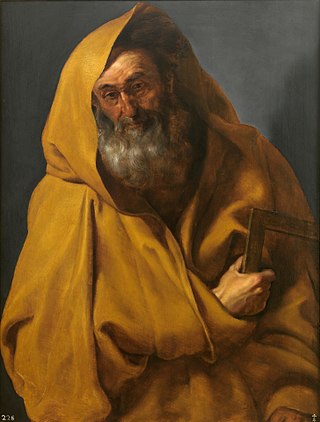
James, son of Alphaeus was one of the Twelve Apostles of Jesus, appearing under this name in all three of the Synoptic Gospels' lists of the apostles. He is generally identified with James the Less and commonly known by that name in church tradition. He is also labelled "the Minor", "the Little", "the Lesser", or "the Younger", according to translation. He is distinct from James, son of Zebedee and in some interpretations also from James, brother of Jesus. He appears only four times in the New Testament, each time in a list of the twelve apostles.

The following outline is provided as an overview of and topical guide to Christianity:

In Christian theology and ecclesiology, the apostles, particularly the Twelve Apostles, were the primary disciples of Jesus according to the New Testament. During the life and ministry of Jesus in the 1st century AD, the apostles were his closest followers and became the primary teachers of the gospel message of Jesus. There is also an Eastern Christian tradition derived from the Gospel of Luke that there were seventy apostles during the time of Jesus' ministry.

Saint Peter, also known as Peter the Apostle, Simon Peter, Simeon, Simon, or Cephas, was one of the Twelve Apostles of Jesus Christ and one of the first leaders of the early Christian Church. He appears repeatedly and prominently in all four New Testament gospels as well as the Acts of the Apostles. Catholic tradition accredits Peter as the first bishop of Rome—or pope—and also as the first bishop of Antioch.
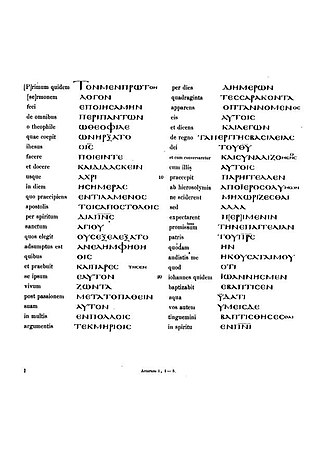
Acts 1 is the first chapter of the Acts of the Apostles in the New Testament of the Christian Bible. The book containing this chapter is anonymous, but early Christian tradition affirmed that Luke composed this book as well as the Gospel of Luke. This chapter functions as a transition from the "former account" with a narrative prelude, repeated record of the ascension of Jesus Christ with more detail and the meeting of Jesus' followers, until before Pentecost.
Justus I Bishop of Jerusalem, whose Jewish name is Judas, was a 2nd-century Jewish Christian leader and according to most Christian traditions the third Bishop of Jerusalem, whose episcopacy was about 107–113 AD. He succeeded Simeon the son of Clopas who died crucified in 107/108, or in 115-117. He is probably a son of James, brother of Jesus and sometimes identified as the New Testament's "Jude of James", otherwise Jude the Apostle. His successor Zacchea I is also called "the Righteous", since this is the meaning of the Aramaic Zakka.
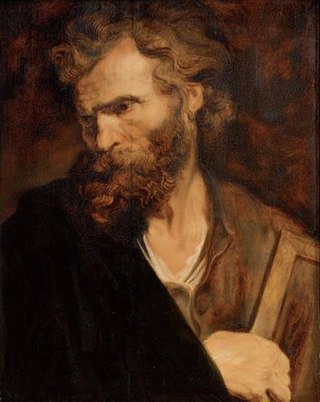
The names Judas and Jude, both derived from the Greek Ἰούδας (Ioúdas), itself derived from the Hebrew name Judah together appear 36 times in the New Testament. Judas was a very common given name in the historical period and region of Jesus, due to the renowned hero Judas Maccabeus. As surnames were still very rare, it is therefore not always clear which person these names refer to, and whether some refer to the same person or distinct characters, which has led to confusion. Therefore, Christian authors and modern scholars have given these men names based on their known attributes. 'Judas' is sometimes rendered as 'Jude' in English in order to help distinguish some of the people named Ἰούδας in the New Testament, even though the original Greek texts make no such distinction.
References
- ↑ "Ioustos: Matthew 1:19 and Colossians 4:11". Biblehub.
- ↑ "Occurrences of the Greek word "dikaios" in the Bible". Bible hub.
- ↑ "Robert Eisenman's "James the Brother of Jesus": A Higher-Critical Review". www.depts.drew.edu.
- ↑ eusebius, Ecclessiastical History III.39.9
- ↑ Mark 16.18
- ↑ Josephus, Wars of the Jews, Book 4, chapter 8, section 1
- ↑ Bishop Demetri Khoury, A Cloud of Witnesses: Saints and Martyrs from the Holy Land, page 628
- ↑ Martyrologium Romanum, ex decreto sacrosancti oecumenici Concilii Vaticani II instauratum auctoritate Ioannis Pauli Pp. II promulgatum, editio [typica] altera, Typis Vaticanis, A.D. MMIV (2004), p. 401 ISBN 88-209-7210-7
- ↑ "Apostle Justus of the Seventy". www.oca.org. Retrieved 2024-08-08.
- ↑ "Synaxis of the Seventy Apostles". www.oca.org. Retrieved 2024-08-08.